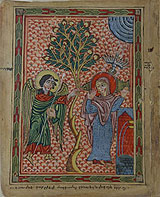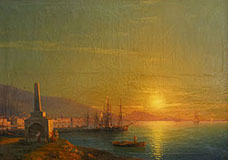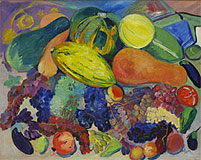Collection / Armenian
Painting

The exposition of Armenian classical art starts with the copies of medieval frescos and miniatures, made by a group of Armenian painters in 1936-1951 under the supervision of the outstanding expert in Armenian art Lidia Durnovo (1885-1963). Overtime losses and damage caused fresco paintings endow the copies kept in the Museum with the value of the originals. The artistic traditions are evidenced by the works of the greatest Armenian miniaturists of the past Toros Roslin, Sargis Pitsak, and others.
 The Armenian art of the eighteenth-twentieth centuries is difficult to appraise outside the context of the cultural connections with Russia, Western Europe, and Eastern countries. Works with religious themes as well as fine artistic legacy of the Hovnatanian family. Most comprehensively represented is the art work of the brightest of the family Hakob Hovnatanian (1806-1881), who worked in Tiflis in 1830-1880. The series of his portraits are witness to the spirit and atmosphere of his epoch. His portraits stress the individuality of his models, and their position in the social hierarchy. They are marked by high artistic quality and interest towards the finest details.These qualities have determined Hovnatanian's place in the history of Armenian painting as the founder of the portrait genre.
The Armenian art of the eighteenth-twentieth centuries is difficult to appraise outside the context of the cultural connections with Russia, Western Europe, and Eastern countries. Works with religious themes as well as fine artistic legacy of the Hovnatanian family. Most comprehensively represented is the art work of the brightest of the family Hakob Hovnatanian (1806-1881), who worked in Tiflis in 1830-1880. The series of his portraits are witness to the spirit and atmosphere of his epoch. His portraits stress the individuality of his models, and their position in the social hierarchy. They are marked by high artistic quality and interest towards the finest details.These qualities have determined Hovnatanian's place in the history of Armenian painting as the founder of the portrait genre.
 The exposition of the Museum illustrates the art of various generations of Armenian masters, revealing common features between painters living abroad and repatriates. Within the collection the works of the famous painter of seascapes Hovhannes Ayvazovsky (1817-1900) play an important role. After the master's museum in Theodosia the Gallery possesses the largest collection of his paintings. These include sixty-two works, among which are Aivazovsky's compositions on Armenian themes: “Byron on the Island of San Lazzaro” and “Noah Descends Ararat”. His favourite marine scenes are combined with Armenian motifs, clarifying Aivazovsky’s concern for the fate of his compatriots who survived the massacres. This also illustrates his interest and role in the formation of the artistic biography of many other Armenian painters.
The exposition of the Museum illustrates the art of various generations of Armenian masters, revealing common features between painters living abroad and repatriates. Within the collection the works of the famous painter of seascapes Hovhannes Ayvazovsky (1817-1900) play an important role. After the master's museum in Theodosia the Gallery possesses the largest collection of his paintings. These include sixty-two works, among which are Aivazovsky's compositions on Armenian themes: “Byron on the Island of San Lazzaro” and “Noah Descends Ararat”. His favourite marine scenes are combined with Armenian motifs, clarifying Aivazovsky’s concern for the fate of his compatriots who survived the massacres. This also illustrates his interest and role in the formation of the artistic biography of many other Armenian painters.
A considerable part of the Museum’s exposition represents classics of Armenian artists and its greatest contributors Vardges Sureniants (1860-1921), Sepan Aghajanian (1863-1940), Panos Terlemezian (1865-1941), Eghishe Tadevosian (1870-1936), Gevorg Bashinjaghian (1857-1925), Martiros Sarian (1880-1972) and Hakob Kojoyan (1883-1959), whose role in the formation of Armenian art is great and undisputable. By combining the artistic movements of Realism, Romanticism, and the achievements of Impressionism, post – Impressionism and Modernism with national traditions, they represented the original essence of the Armenian culture.
Through the course of time many talented and original painters were integrated into the Soviet artistic life.These include painters Martiros Sarian (1880-1972), Hakob Kojoyan (1883-1959), Sedrak Arakelian (1884-1942), Sedrak Rashmajian (1907-1978), Ara Bekaryan (1913-1986), Edvard Isabekyan (1914-2007), Hovhannes Zardarian (1918-1992), Hmayak Avetisian (1912-1978), Eprem Savayan (1909-1974) – the new range of themes connected with the names of these well-known masters stimulated the formation of the national cultural character.
 An integral part of this culture was the work of a number of painters, among them Bedros Kontradjian (1905-1965), Bartugh Vardanian (1897-1978), Ararat Gharibyan (1903-1952), Haroutian Kalents (1910-1966), Hovhannes Asatryan (1914-2007), Hakob Hakobian (1923), who worked also abroad adopting the artistic experience of the French school. Although representing various generations and artistic trends, they are united by high professional standards. Paris always attracted many Armenian masters such as Georgi Yakoulov (1884-1928), Martiros Sarian (1880-1972), Vahram Gayfejian (1879-1960), and Ervand Kochar (1899-1979),they managed to preserve their individuality in the maelstrom of artistic trends. By representing the avant-garde of the twentieth century, they greatly predetermined the development of modern Armenian painting.
An integral part of this culture was the work of a number of painters, among them Bedros Kontradjian (1905-1965), Bartugh Vardanian (1897-1978), Ararat Gharibyan (1903-1952), Haroutian Kalents (1910-1966), Hovhannes Asatryan (1914-2007), Hakob Hakobian (1923), who worked also abroad adopting the artistic experience of the French school. Although representing various generations and artistic trends, they are united by high professional standards. Paris always attracted many Armenian masters such as Georgi Yakoulov (1884-1928), Martiros Sarian (1880-1972), Vahram Gayfejian (1879-1960), and Ervand Kochar (1899-1979),they managed to preserve their individuality in the maelstrom of artistic trends. By representing the avant-garde of the twentieth century, they greatly predetermined the development of modern Armenian painting.
 Martiros Sarian’s (1880-1972) role in the formation of the Armenian painting is extraordinary. In his paintings Sarian vividly and graphically expressed Armenian mentality and world outlook. At the same time he was an innovator. Alongside with other prominent artists of the twentieth century, he invented new paths in modern art and new artistic solutions. Sarian was a born master of colour, compositions, and drawings. His gift for abstraction made it possible to transform the images of his motherland into a universal image of the world, into a meditation about its creation, its mutability, and the role of the man in it. At the same time Saryan’s paintings remain purely Armenian depicting its nature and people, the mountains, and the sunny landscapes. Saryan’s work also combines the two polar edges of Armenian mentality – the East and the West. For the Armenians the East is not only a natural environment, way of thinking or traditional mode of life, but also a part of culture vividly expressed in the poetry of Sayat-Nova and Avetik Isahakyan, in the paintings of Vardges Sureniants (1860-1921), and the films of Sergey Parajanov.
Martiros Sarian’s (1880-1972) role in the formation of the Armenian painting is extraordinary. In his paintings Sarian vividly and graphically expressed Armenian mentality and world outlook. At the same time he was an innovator. Alongside with other prominent artists of the twentieth century, he invented new paths in modern art and new artistic solutions. Sarian was a born master of colour, compositions, and drawings. His gift for abstraction made it possible to transform the images of his motherland into a universal image of the world, into a meditation about its creation, its mutability, and the role of the man in it. At the same time Saryan’s paintings remain purely Armenian depicting its nature and people, the mountains, and the sunny landscapes. Saryan’s work also combines the two polar edges of Armenian mentality – the East and the West. For the Armenians the East is not only a natural environment, way of thinking or traditional mode of life, but also a part of culture vividly expressed in the poetry of Sayat-Nova and Avetik Isahakyan, in the paintings of Vardges Sureniants (1860-1921), and the films of Sergey Parajanov.
 Eastern spirit and atmosphere permeates through the pensive, dreamy and refined world of the Armenian painters of Tiflis,which was the centre of Armenian intellectual and cultural life in the seventeenth-twentieth centuries. The Hovnatanian family, Gevorg Bashinjaghian (1857-1925), Georgi Yakoulov (1884-1928), Hovsep Karalian (1897-1981), Vano Khojabekian (1857-1922), Gevorg Grigoryan (Giotto) (1897-1976), Hakobjan Gharibjanian (1902-1987), and Vehik Ter-Grigorian (1903-1965), Vagharshak Elibekyan (1910-1994) form the incomplete list of those artists represented in the exposition of the Gallery.Huge imagination, acute sense of beauty, and intense temperament are characteristic of the works of Alexander Bazhbeuk-Melikian (1891-1966). These are brilliantly expressed in the world of female images, which are filled with refined sensuality. This is one of the most captivating sections of the Gallery’s exposition.
Eastern spirit and atmosphere permeates through the pensive, dreamy and refined world of the Armenian painters of Tiflis,which was the centre of Armenian intellectual and cultural life in the seventeenth-twentieth centuries. The Hovnatanian family, Gevorg Bashinjaghian (1857-1925), Georgi Yakoulov (1884-1928), Hovsep Karalian (1897-1981), Vano Khojabekian (1857-1922), Gevorg Grigoryan (Giotto) (1897-1976), Hakobjan Gharibjanian (1902-1987), and Vehik Ter-Grigorian (1903-1965), Vagharshak Elibekyan (1910-1994) form the incomplete list of those artists represented in the exposition of the Gallery.Huge imagination, acute sense of beauty, and intense temperament are characteristic of the works of Alexander Bazhbeuk-Melikian (1891-1966). These are brilliantly expressed in the world of female images, which are filled with refined sensuality. This is one of the most captivating sections of the Gallery’s exposition.
Sarian’s artistic inventions and his innovative manner were transformed by the following generation of painters: Mariam and Yeranuhi Aslamazian, Lavinia Bazhbeuk-Melikian (1922-2005), Sargis Muradyan (1927-2007), Nikolay Kotanjyan (1928), Minas Avetisyan (1928-1975), Ashot Hovhannisyan (1929-1997), Henrik Siravyan (1928-2001), Alexander Grigoryan (1927-2008), Ruben Adalian (1929), Varos Shahmuradyan (1940-1977), and Seyran Khatlamajian (1937-1994). Though varying in their artistic temperament, these artists nevertheless share common features. The drive to combine national traditions with the achievements of modern art as a whole is characteristic of these painters and Armenian art in general.
 The artistic mentality of the Armenian masters, characterized by their use of abstraction, symbolism, and colouristic language is to a great extent accordant with the search for the synthesis of colour and form, which is typical of modern art. Striking examples of this are the works of Minas Avetisyan (1928-1975). Endowed with an outstanding sense of the emotional nature of colour, he combined the traditions of medieval Armenian painting with the style of the post-Impressionists and Fauvists. The synthesis of form with colour is characteristic of the artistic mentality of other Armenian painters as well, among them Ashot Hovhannsiyan (1929-1997), Lavinya Bazhbeuk-Melikian (1922-2005), Sargis Muradyan (1927-2007), Grigor Khanjian (1926-2000), Hrachya Hakobian (1935-1982), Anatoli Papyan (1924-2007) and others. The Gallery collection also includes works by a number of modern painters: Edward Artsrunyan (1929), Alexander Grigoryan (1927-2008), Albert Parsamyan (1935-1995), Ruben Adalyan (1929), Karen Smbatyan (1932-2008), Edward Kharazyan (1939), Henri Elibekian (1936), Robert Elibekian (1941), Varuzhan Vardanyan (1948-2010), Ruben Abovyan (1948), Ashot Bayandur (1947-2003), Paravon Mirzoyan (1949), Karo Mkrtchyan (1951-2001), Aram Isabekyan (1952) and others. Introducing the viewers to the artistic search and ideals of several generations of Armenian painters, the Museum collection reveals the various manifestations of their world outlook, which gradually shaped the image of modern Armenian art.
The artistic mentality of the Armenian masters, characterized by their use of abstraction, symbolism, and colouristic language is to a great extent accordant with the search for the synthesis of colour and form, which is typical of modern art. Striking examples of this are the works of Minas Avetisyan (1928-1975). Endowed with an outstanding sense of the emotional nature of colour, he combined the traditions of medieval Armenian painting with the style of the post-Impressionists and Fauvists. The synthesis of form with colour is characteristic of the artistic mentality of other Armenian painters as well, among them Ashot Hovhannsiyan (1929-1997), Lavinya Bazhbeuk-Melikian (1922-2005), Sargis Muradyan (1927-2007), Grigor Khanjian (1926-2000), Hrachya Hakobian (1935-1982), Anatoli Papyan (1924-2007) and others. The Gallery collection also includes works by a number of modern painters: Edward Artsrunyan (1929), Alexander Grigoryan (1927-2008), Albert Parsamyan (1935-1995), Ruben Adalyan (1929), Karen Smbatyan (1932-2008), Edward Kharazyan (1939), Henri Elibekian (1936), Robert Elibekian (1941), Varuzhan Vardanyan (1948-2010), Ruben Abovyan (1948), Ashot Bayandur (1947-2003), Paravon Mirzoyan (1949), Karo Mkrtchyan (1951-2001), Aram Isabekyan (1952) and others. Introducing the viewers to the artistic search and ideals of several generations of Armenian painters, the Museum collection reveals the various manifestations of their world outlook, which gradually shaped the image of modern Armenian art.